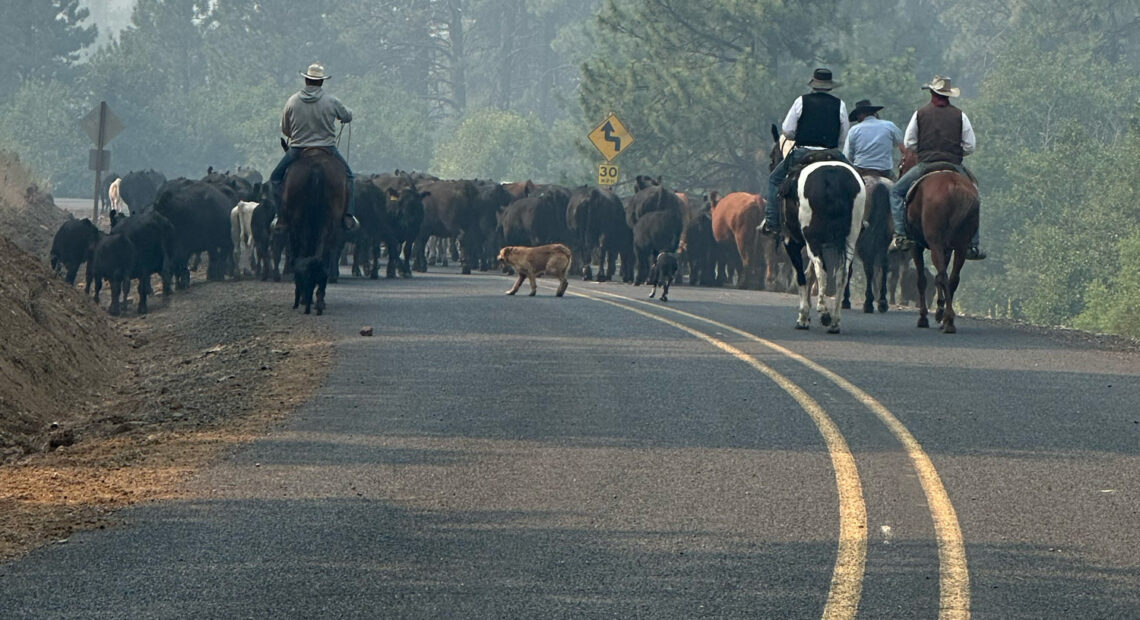
Burnt over cattle and lands: In southeast Oregon, grief-stricken ranchers are exhausted and frustrated by wildfires
Listen
(Runtime 4:33)
Read
Exhaustion and frustration: Ranchers in southeast Oregon are battling wildfire. Like many more rural landowners across the West, they’re strapped with harrowing work and crushing devastation.
And fire season is expected to hit peak burn in mid-August.
Sabrina Maki is a rancher east of Burns, Oregon. Her whole family tends a large ranch spanning a swath of Harney County.
She said her family’s 74,000-acre ranch — both deeded and leased government ground — ranges from juniper, tall stands of pine, draws with creeks to flats of sage and irrigated alfalfa. Much of it is significantly burned, sometimes right up to their irrigated fields.
Some is still burning, and it’s hard to know for sure right now how many acres are truly gone, she said.
“We’ve now had three separate fires on our property since the Fourth of July,” Maki said. “Two of them we got out.”
The Telephone Fire is still burning on their property — it’s at 46,000 acres burned as of Friday morning.
The Rattlesnake Creek Ranch, owned by Maki’s parents, runs about 1,200 cow-calf pairs — mostly angus. But now, much of what two-thirds of those cattle usually graze in the summers is black. It will take years to recover enough for cattle to return there, she said.
And so many ranchers are in the same situation — there’ll be little open ground to move cattle to, when the fires quiet, Maki said.
“Where can you find grazing?” Maki asked. “The answer is nowhere — we are one of thousands of ranchers that has lost their grazing — from Washington, to Oregon, to Idaho, to California, all the way to Texas.”
That’s going to be a problem for thousands of cattle that have been trailed to low country and saved.
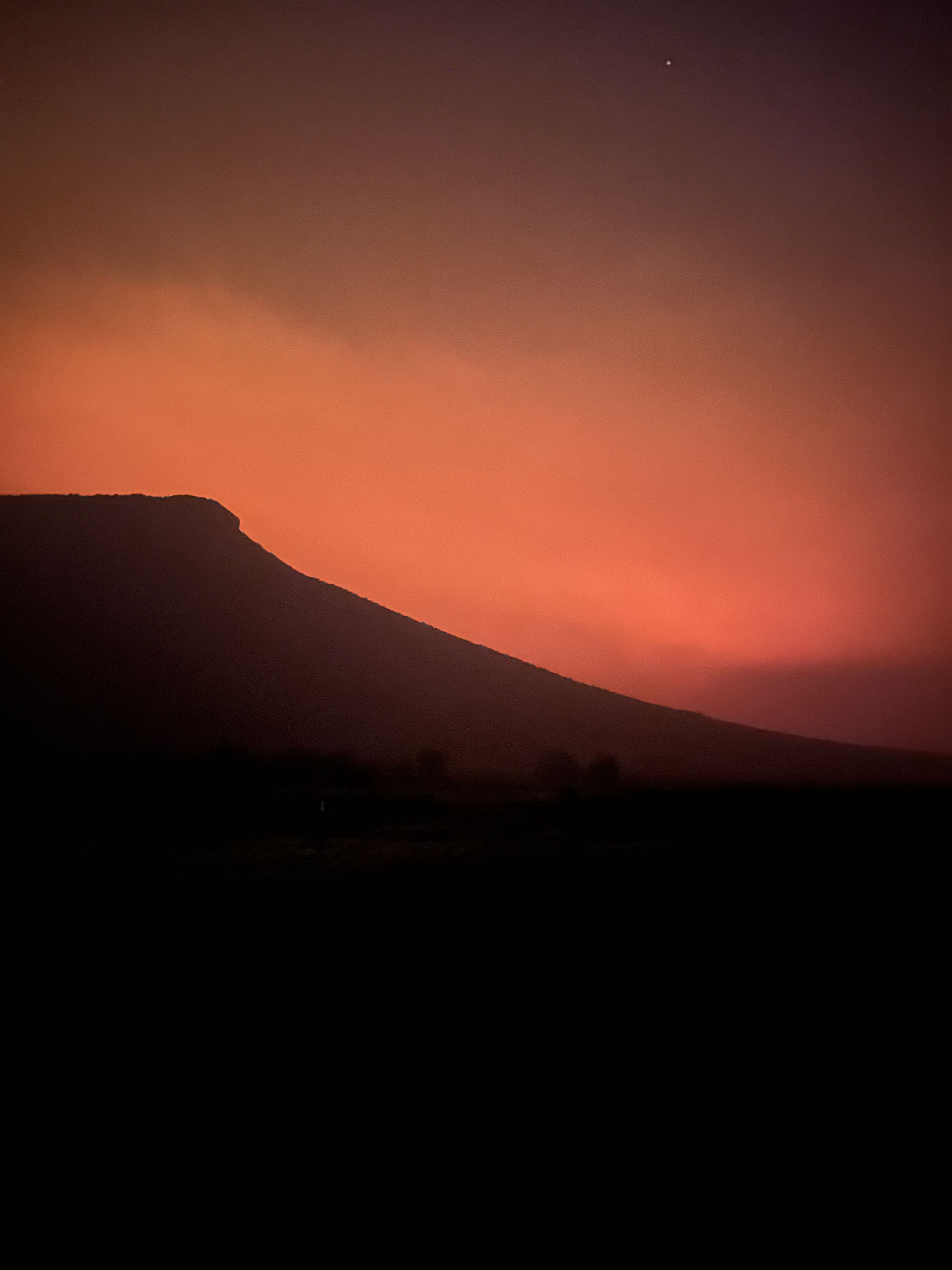
The nighttime view outside of Sabrina Maki’s back door when the Telephone Fire was coming down Mortimer Canyon toward her home on July 26 outside of Burns, Oregon.
(Credit: Sabrina Maki)
Burnt over
Still unfolding is how many cattle have been burnt over across the West in these wind-driven fires.
Officials like the Oregon Department of Emergency Management, the Oregon Cattlemen’s Association and Oregon Gov. Tina Kotek’s office all say it’s too early to tell.
Rancher Maki said she knows one family very well that has likely lost several hundred head of cattle in Harney County.
The matriarch of that same family that lost cattle offered to help Maki’s family when they were at the brunt end of the Telephone Fire a few days ago, Maki said.
“The outpouring of those offers of help are humbling, it’s so appreciated and there is so much gratitude,” Maki said.
She said their cow boss, hands and even the farm crew and neighbors have all been pressed into firefighting work at all hours since the fires began.
Matt McElligott is the president of the Oregon Cattlemen’s Association. He’s based in North Powder, Oregon. McElligott said losing cattle is no small deal economically for ranchers, but also it’s emotional.
“Most of these animals we have raised from babies, and sometimes three, four or more generations,” he said. “And like you’re children, you know, you’re really emotionally attached to these cattle. Even if you have 100 of ‘em to 500 of ‘em or 600 of ‘em. You know the calves and you know what moms they came out of.”
He said it’s too soon to know just how many animals have burnt up in the fast-moving fires ripping through timber and sagebrush. One of McElligott’s friends lost thousands of acres of range to fires, and most everything but his home.
“And as he started looking, he found most all his cattle on green spots throughout his ranch — on creek bottoms and canyons, where the cattle went to and the fire went around ‘em,” McElligott said.
McElligott said he’s trying to keep his cattle safe, bale enough hay for the winter season and pass critical information to his friends and colleagues in the cattle industry all at the same time.
Shane Otley is frustrated and exhausted too. He’s the second vice president of the Oregon Farm Bureau. He said one problem is that many ranchers have cattle pre-sold on contracts.
“Now they have dead cattle,” he said. “Some of these mother cows are three to five years old — and they had good years and calves in them.”
To replace those animals that know the ground would take over three years with a young animal, he said. Those mature mother cattle are the leaders that help the herd negotiate this tough country.
“When you have a cow on the ranch that knows the ranch, knows where the water is, it takes years to recover,” Otley said.
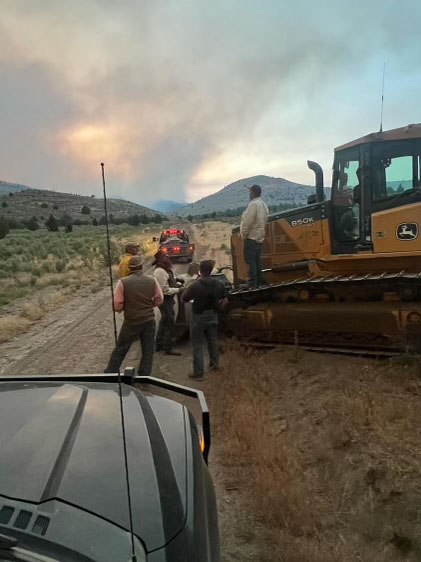
The Rattlesnake Creek Ranch crew building lines by themselves outside an area called Cow Creek on the Telephone Fire outside of Burns, Oregon.
(Credit: Sabrina Maki)
Tooth and nail
As of Friday, the Telephone Fire is 23% contained.
Maki tells a story of when her family and crew built a miles-long fire line up on their allotments, but then the fire jumped a 3-mile section that was left uncompleted by federal firefighters.
The family is simmering. “We have lost ground, livestock and grazing and miles of fence and infrastructure,” Sheryden Cary, Maki’s sister, said at a recent firefighting community meeting in downtown Burns. “Everyday it burns a little closer, and everyday they (federal firefighters) say they don’t have the resources to put it out.”
Maki also recounts when the fire blew up in the canyon right behind her home the night of July 26. The fire also came close to her parents’ home nearby. That night, the fire marched forward toward their homeplaces by the mile, driven by wind.
But she said nearby firefighters were not helping until nearly too late. Her family dug lines around their properties with their own equipment and fought the fire, while trying to bale oat hay and get the bales out of the way so they could turn on more irrigation water.
“It’s hard to know — the anger piece — where to direct it,” she said. “I don’t want to be mad at a firefighter. The locals have been really good to us. But this bureaucracy and mismanagement is hard. We’re all exhausted.”
August is typically the peak of fire season for Washington, Oregon, Idaho and California.
“Another spot fire just started by a different neighbor’s cabin,” Maki said. “We’re going to be dealing with this until it rains, and it doesn’t rain often in our parts.”
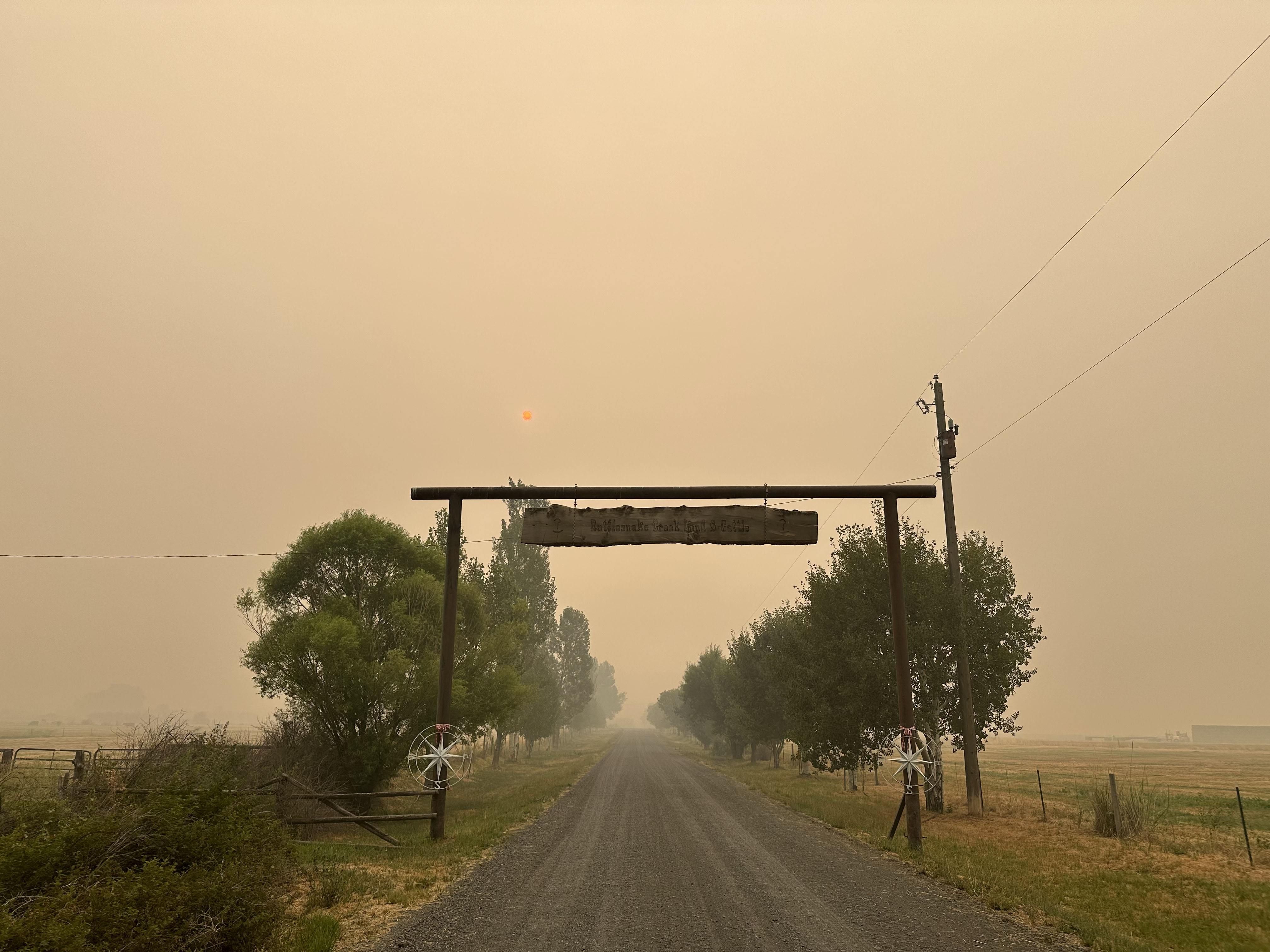
The Rattlesnake Creek Ranch outside of Burns, Oregon, has been under siege from fire this summer, like many ranches across the West.
(Credit: Sabrina Maki)
Moving cattle
Many ranchers are having to ride tough mountain country to trail out and save hundreds of the same cattle again and again. They move the animals into meadows they think are safe, but then the fire eats up the margin of ground within a day. Often, the cattle turn around and head back toward danger — looking for fresh grass.
“They’re looking at us like, ‘What are you doing, it’s not time to go home,’” said Kayce Faulkner, another rancher in the Burns area. She said the cattle don’t want to come home to lower ground, because there is plenty of feed still in the mountains. They move more easily in the fall, when the grass has run out, she said.
“But the kind of unnerving thing of riding out there with the smoke and everything, is you know the cows don’t understand why they’re leaving, and you’re up there trying to save their life. And it’s kind of frustrating sometimes like, ‘Just go! Would you just do what I ask please?’” Faulkner said.
Faulkner said she’s been up in tough country for weeks now — getting cattle out of dangerous spots and helping her neighbors.
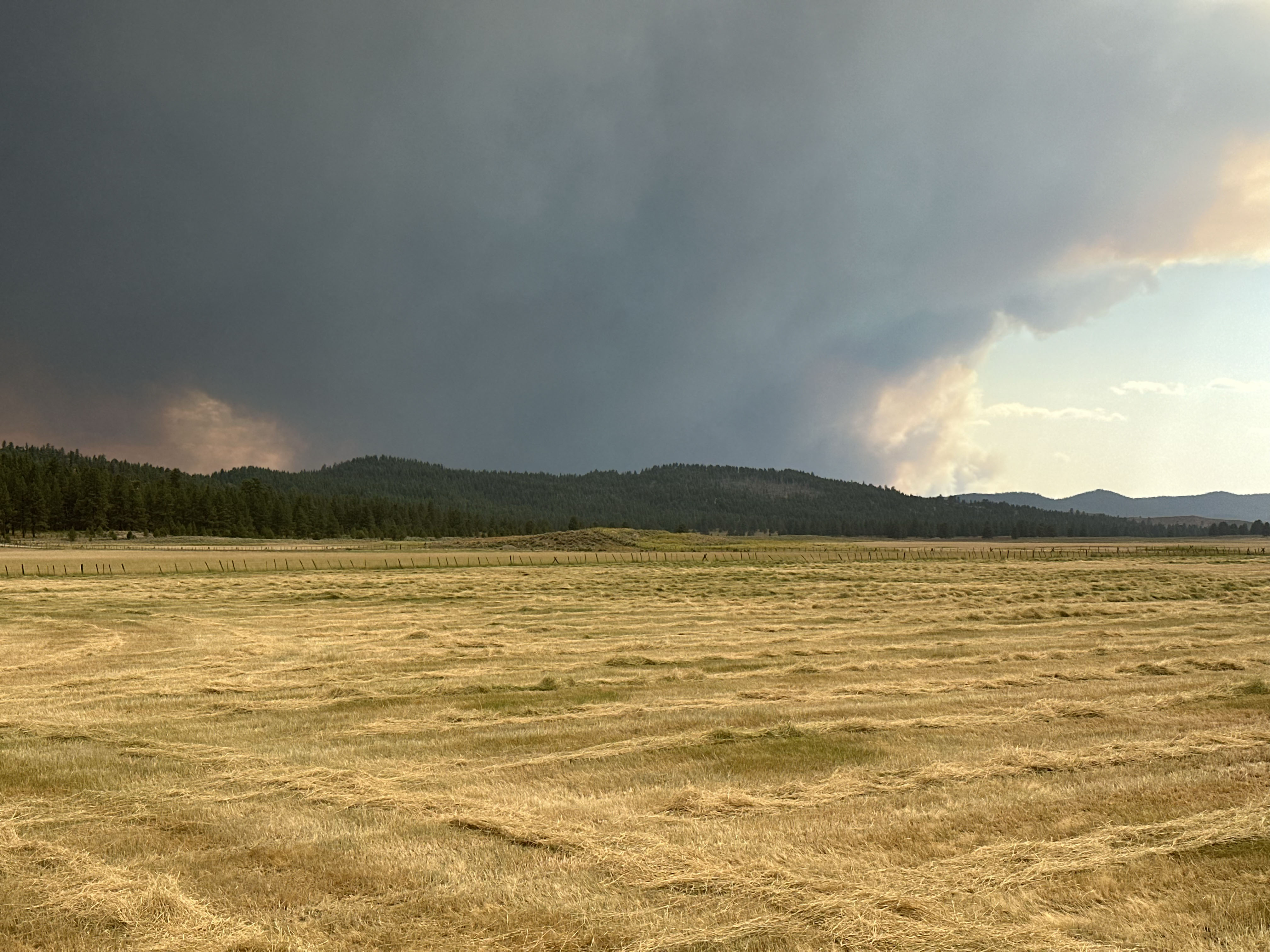
A field of wild meadow grass hay still needs to be baled. In the distance is the Falls Fire, looking southwest from Seneca, Oregon, on July 13.
(Credit: Shane Otley)
Bale out
At the same time that it’s needed, much of the cut hay won’t dry out in southeast Oregon. That’s because of a tight lid of wildfire smoke. Like many of his ranching and farming neighbors, Otley’s got hay cut down, but it won’t dry enough to bale.
“It brings people down,” Otley said.
Otley lives east of Burns. The alfalfa and timothy hay in that area normally goes to export, dairies and local consumption.
“Even in our community, the people that aren’t in the livestock business – they’re seeing the toll that it’s taken on the cattle producers and hay producers,” he said. “It’s just, this is what their community is, it’s cattle and hay.”
Hay and pasture is much needed in southeast Oregon right now. Many cattle have had to be trailed out of mountain forests and meadows to the low, irrigated country away from fires.
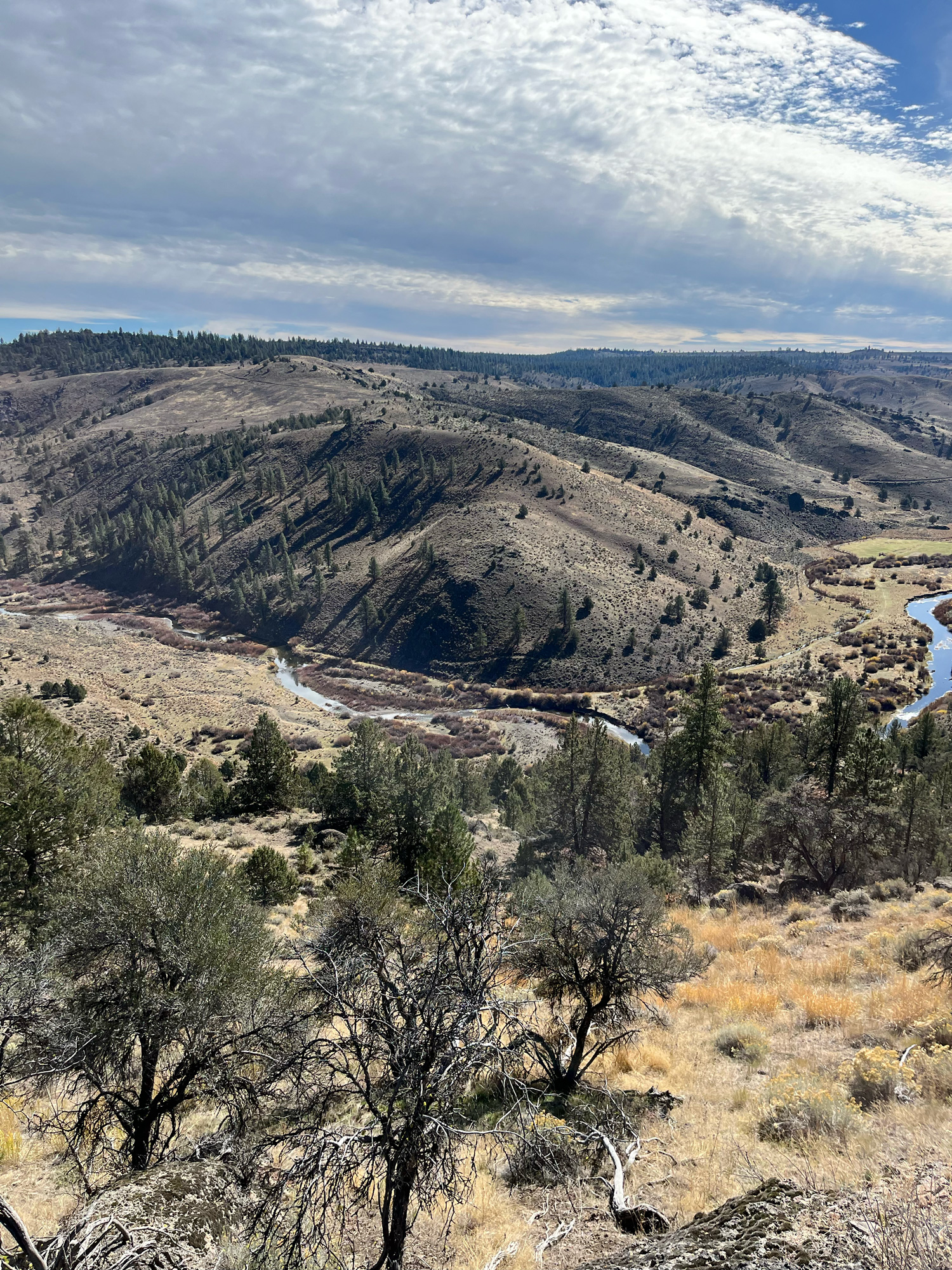
The Silvies River bends around Mitch Baker’s ranch outside of Burns, Oregon. This photo was taken before the Falls Fire turned everything black.
(Credit: Mitch Baker)
Every creek
Mitch Baker, and his wife, Linda, have lost nearly one entire family ranch in the Falls Fire. They still have more ground that hasn’t burned, but he is frustrated too by federal wildfire resources not fighting to save his buildings, property and infrastructure.
“All the resources are sitting there, and no one does anything,” he said.
Baker said it was just a week too early to move them, or his cattle would have been right in the path of the fire.
“It was a whole lot of luck we didn’t have a whole lot of cattle up in the burn,” he said.
Moving out what they could was still terribly hard, and scary. Their crew were working at night sometimes and in heavy smoke where they could only see a hundred feet or so.
“Down there in the canyon, it was so smokey they could hardly see the cows,” Baker said. “They were gatherin’ what they could actually kind of bump into.”
Baker said he’s got most of his cattle down in the low country now in green irrigated pastures. But there’s one bull he still can’t find.
“He’s probably under a juniper tree somewhere,” Baker said. “He got his work done, so he’s taken the rest of the summer off.”
But Baker turned serious as he described his heartbreak. The fire burnt up most of the ranch where so many of his memories lived. The property has been the backbone of his entire life — he was only away from this landscape for 10 years when he was in the Navy. He’s nearly 80, and it’s been in his family for over a century.
Baker said he knows every riverlet and creek. It’s all black now.
“You’ve got to think about all the wildlife loss — the big critters to the little ones,” he said. “It’s just all lost.”
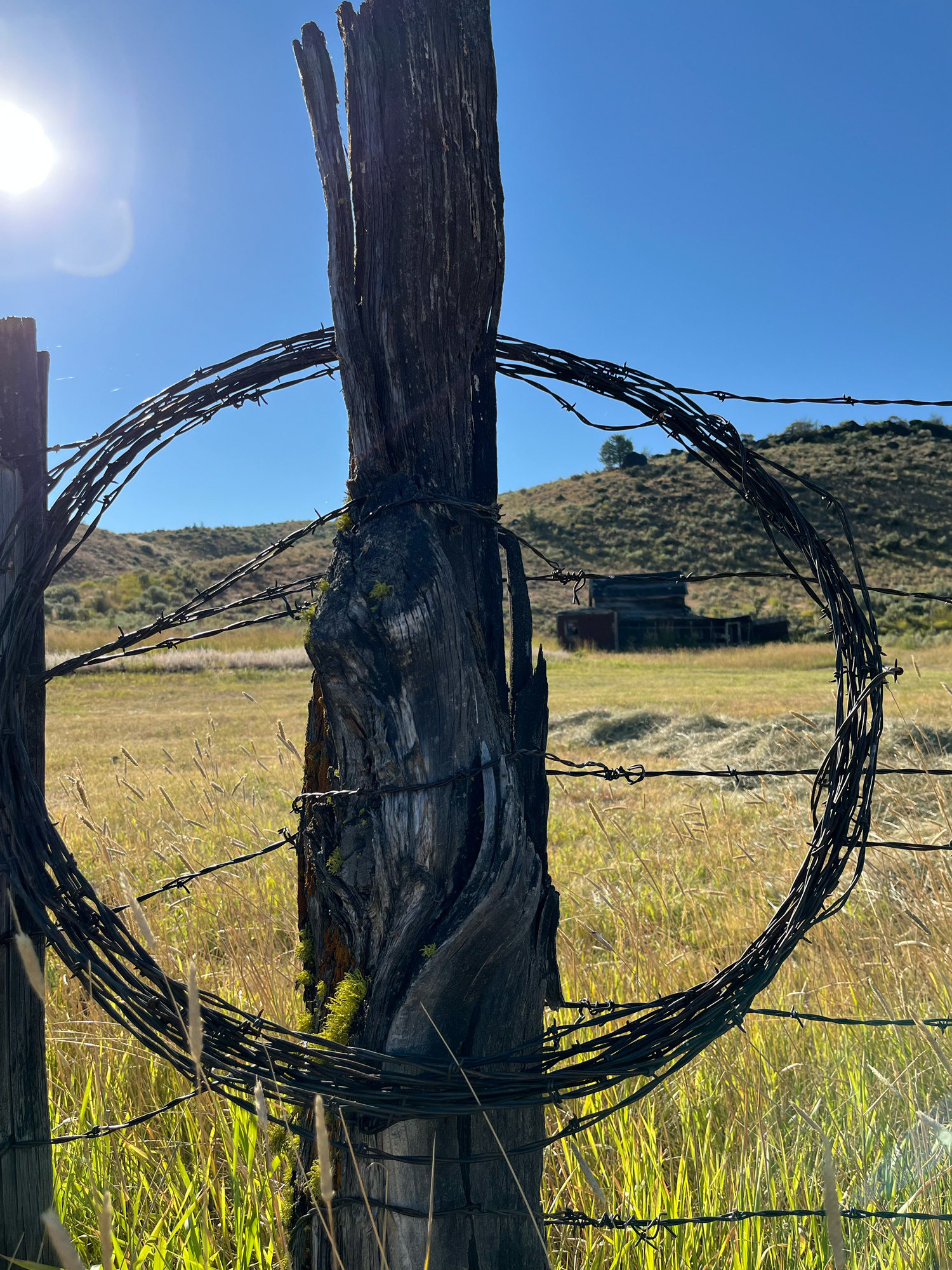
Fence lines are integral to ranching. They help cattle managers avoid overgrazing each area and keep cattle sorted.
(Credit: Mitch Baker)
Barbed wire
A looming and daunting problem that will take years, maybe decades, to recover is the lost fences.
With acreages, like the over 143,000 acres burned on just the Falls Fire in southeast Oregon as of Friday, it’s likely that thousands of miles of fence lines have been burned across the West just this season.
And many ranching families run cattle over a patchwork of private, state, U.S. Bureau of Land Management and U.S. Forest Service ground. So those fence lines too, are a patchwork of posts and wire.
Baker said in many areas it’s nebulous about just who will pay to rebuild the fence — the ranchers or the government? And without fences, cattle can’t be grazed.
“You got to deal with the government and see what they’ll do,” Baker said. “It’s like they don’t give a damn.”
Fences help ranchers manage the landscape, and keep from overgrazing certain areas. It can cost thousands and thousands of dollars to replace even one mile of barbed wire fence.
Also lost are shoots and corrals that help producers doctor, sort and load cattle.
The emotional scars, the landscape, the infrastructure and the ranchers will take time to heal and rebuild if large swaths of the West are to be ranched again.
















